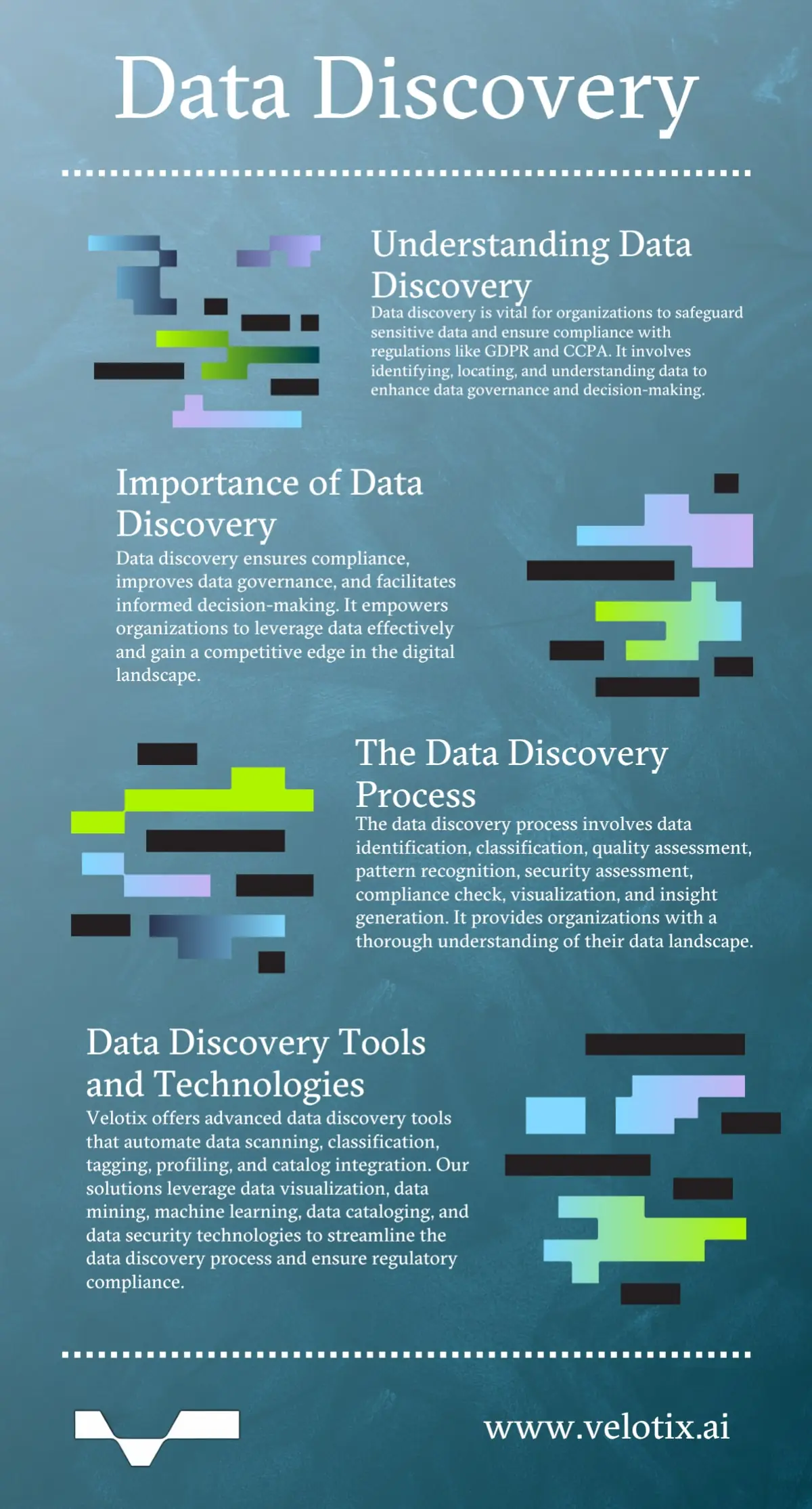Data discovery safeguards organizations from the risks associated with mishandled sensitive data. It includes the identification, location, and understanding of data across multiple environments and ensures data assets are secure and manageable. With data discovery software, enterprises protect themselves from internal and external threats that otherwise could jeopardize operation integrity and stakeholder trust.
What is Data Discovery
If sensitive data, including customer personal information, financial records, or proprietary knowledge, is mishandled or accessed without authorization, it can put your organization at risk of violating global data protection regulations, such as the General Data Protection Regulation (GDPR) and the California Consumer Privacy Act (CCPA). It also deteriorates the trust that customers, partners, and stakeholders place in your company.
Data discovery, sometimes referred to as big data discovery or cloud data discovery, is a process organizations use to obtain a clear understanding of all their data. Much like a comprehensive financial audit, it’s crucial at a time when data-driven decision-making dominates the business landscape. It works by recognizing patterns, identifying anomalies, and uncovering insights from various data sources, ensuring its accuracy, relevance, and applicability to business objectives.
By employing strategies and data discovery tools and technologies like machine learning, AI, and data mining, data discovery automates the filtering of massive datasets, rendering them into comprehensible knowledge and actionable insights.
For instance, a financial services company might use data discovery to identify patterns of fraudulent activities by analyzing transaction data. In a healthcare setting, it could be used to illuminate patterns related to treatment efficacy and patient outcomes, guiding improved healthcare protocols and patient care. And in the telecommunications sector, data discovery can be used to analyze customer usage patterns to aid in the development of personalized service plans and promotions.
Data discovery goes far beyond simple data management, offering a path toward optimized utilization of your organization’s data assets.

The Importance of Data Discovery
Data discovery services are significant for multiple reasons:
- It ensures compliance and mitigates legal repercussions related to various data protection regulations by identifying and safeguarding sensitive information.
- It provides a clear understanding of where and how your organization’s data is stored and used, enhancing data governance and improving data quality and management.
- It facilitates informed decision-making by delivering transparent, accessible, and understandable data.
In an environment where data equals power, data discovery provides organizations with the tools they need to leverage data effectively and gain a competitive edge.
The Data Discovery Process
The data discovery progress helps enterprises make their way through data management’s often intricate landscape, helping them unlock their data’s true potential while maintaining data quality and compliance. It’s a highly orchestrated effort involving various states to ensure data is accurate, reliable, relevant, and compliant.
- Data identification. Determining and earmarking data across multiple platforms and repositories.
- Data classification. Categorizing data based on type, sensitivity, and importance or value.
- Data quality assessment. Evaluating data quality, consistency, and reliability.
- Pattern recognition. Employing algorithms and analytics to discern data patterns and relationships.
- Security assessment. Ensuring sensitive and critical data is protected against unauthorized access and breaches.
- Compliance check. Verifying data management and usage adhere to relevant and current legal and policy requirements.
- Visualization. Employ data tools and technologies to render data into comprehensible, visual formats.
- Insight generation. Analyzing visualized data to extract meaningful and actionable business insights from it.
The data discovery process provides organizations with a thorough understanding of their data landscape and ensures the insights gleaned are backed by accurate, consistent, and secure data. Businesses are better equipped to deal with the complexities of the digital world, and they can be confident their data-driven strategies are impactful and compliant with requisite regulatory frameworks.
Data Discovery Tools and Technologies
The best data discovery tools automatically scan data sources to detect sensitive data and generate tagging, eliminating error-prone manual processes of the past. The process typically involves five steps:
- Scanning. Efficient data scanning begins with systematically examining data across disparate sources to locate and understand the state of stored information.
- Classifying. Discovery data is classified into defined types or categories, such as personal, operational, or financial, to manage and safeguard it effectively.
- Tagging. Descriptive or categorical labels are assigned or attached to data to enhance its traceability and facilitate organized, easy retrieval and management.
- Profiling. Data is evaluated and analyzed to understand its structure, content, relationships, and quality and to maintain its integrity and reliability.
- Catalog integration. Discovered data is incorporated into a central catalog to ensure it is systematically indexed and easily accessible and usable by authorized personnel to complete their tasks.
There is no shortage of tools and technologies to help organizations manage high volumes of data, extract actionable insights, and implement strategic blueprints.
- Data visualization tools enable users to create interactive dashboards and reports to provide graphical representations of data that make it easier to interpret complex datasets.
- Data mining applications delve deep into data to uncover patterns, correlations, and insights that might otherwise go undetected.
- Machine learning libraries use algorithms to analyze data, predict trends, and identify patterns that enrich the data discovery process.
- Data cataloging solutions help organize, find, and manage data, enhancing data governance and quality.
- Data masking and security solutions that protect sensitive information and ensure data remains secure and compliant.
By leveraging these and other data discovery tools, organizations can streamline their data discovery processes, ensuring they harness their data’s full potential and meet various regulatory requirements.